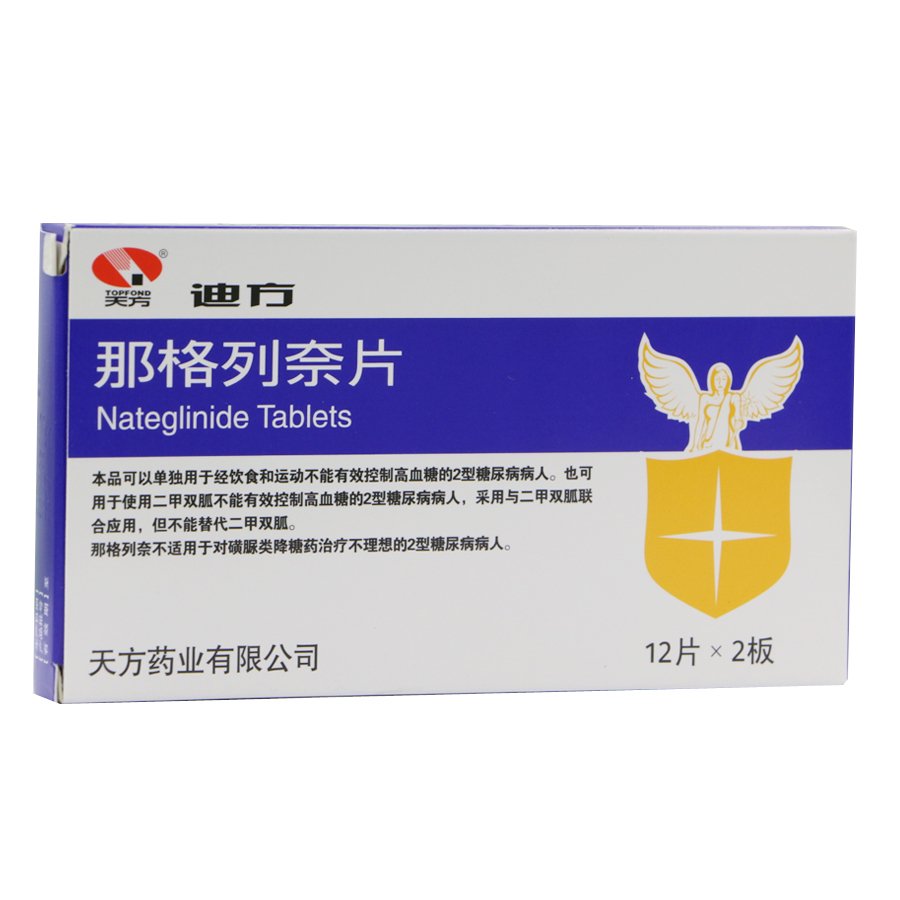Nateglinide Tablets
Effects and efficacy:
Nateglinide tablets can promote insulin secretion and are mainly used for type 2 diabetes. This product can be used alone for type 2 diabetes that cannot effectively control hyperglycemia through diet and exercise. It can also be used for type 2 diabetes that cannot effectively control hyperglycemia with metformin (but it cannot replace metformin). Note: Nateglinide is not suitable for type 2 diabetes patients who are not ideal for sulfonylurea hypoglycemic treatment.
Usage and Dosage:
The usual dose of this product is 120 mg before meals. It can be used alone or in combination with metformin. The dose should be adjusted according to the results of regular HbA1c tests (the maximum recommended dose is 180 mg, 3 times a day). Because the main therapeutic effect of nateglinide is to reduce blood sugar during meals (which is an important component of HbA1c), the therapeutic effect of nateglinide can also be monitored by blood sugar 1-2 hours after meals. In clinical trials, nateglinide is usually taken before the main meals, namely breakfast, lunch and dinner. For patients whose HbA1c levels are close to the treatment target at the beginning of treatment (i.e., HbA1c < 7.5%), nateglinide 60 mg can be taken before meals alone or in combination with metformin, and the dose can be adjusted according to the effect of treatment. Dosage for patients with liver damage: The drug dose does not need to be adjusted for patients with mild to moderate liver disease. The medication situation of patients with severe liver disease has not been studied, so patients with severe liver disease should not use nateglinide. Dosage for patients with renal impairment: No dose adjustment is required for patients with mild to moderate renal impairment. Although the Cmax of dialysis patients is reduced by 49%, the bioavailability and half-life of nateglinide are comparable to those of healthy subjects in diabetic patients with moderate to severe renal insufficiency (creatinine clearance 15-50ml/min) and patients requiring dialysis. However, for the sake of drug safety, the dose should be adjusted if a low Cmax occurs. The same drugs produced by different manufacturers may have inconsistent instructions. If you find that the instructions are inconsistent before taking the drug, please consult a doctor or pharmacist in time.
Adverse reactions:
Like other antidiabetic drugs, symptoms of hypoglycemia can be observed after taking nateglinide. Symptoms include sweating, shivering, dizziness, increased appetite, palpitations, nausea, fatigue and weakness. These symptoms are generally mild and easy to handle, and carbohydrates can be eaten if necessary. Clinical research reports show that the proportion of patients with hypoglycemia symptoms and confirmed blood sugar reduction (blood sugar < 3.3mmol/L) is 2.4%. Liver function: Very few patients have increased liver enzymes, which are mild and transient, and rarely lead to discontinuation of medication. Allergies: There are very few reports of allergic reactions such as rash, itching and urticaria. Other reactions: Other adverse events found in clinical trials include gastrointestinal reactions (abdominal pain, indigestion, diarrhea), headaches, etc. It should also be noted that there have been reports of myocardial infarction in cases taking this drug abroad, and there are also sudden deaths of unknown causes. Therefore, careful observation should be made when administering the drug; if abnormal conditions are found, administration should be stopped immediately and appropriate treatment measures should be taken.
Contraindications:
Contraindicated if allergic to this product Contraindicated during pregnancy Contraindicated during lactation Use with caution if insufficiency of liver and kidney function Use with caution while driving
Share:
Products
Our offers
Health Classification
Let us work together to protect precious health






























